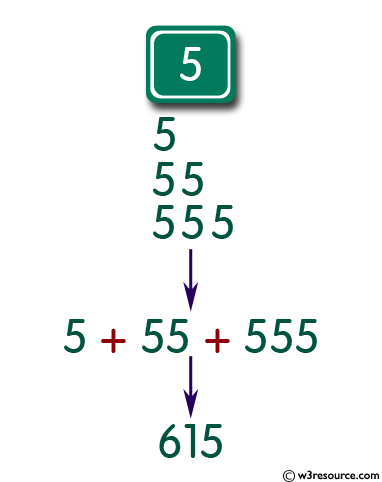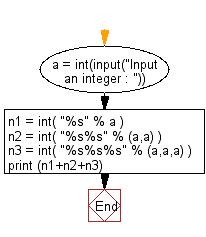Write a Python Program That Reads in N Integers and Stores It in a List of Integers.
Python: Input an integer (n) and computes the value of n+nn+nnn
Python Basic: Exercise-10 with Solution
Write a Python program that accepts an integer (n) and computes the value of n+nn+nnn.
Sample value of n is v
Python int(10, base=10):
The function returns an integer object constructed from a number or string x, or return 0 if no arguments are given. If x is a number, return x.__int__(). For floating point numbers, this truncates towards nada.
- If x is not a number or if base of operations is given, then x must be a string, bytes, or bytearray instance representing an integer literal in radix base
- The literal tin can be preceded by + or - (with no space in between) and surrounded by whitespace
- A base of operations-n literal consists of the digits 0 to n-i, with a to z (or A to Z) having values ten to 35. The default base is 10.
- The allowed values are 0 and 2-36. Base-2, -8, and -16 literals can be optionally prefixed with 0b/0B, 0o/0O, or 0x/0X, as with integer literals in code.
Pictorial Presentation:

Sample Solution :-
Python Lawmaking:
a = int(input("Input an integer : ")) n1 = int( "%s" % a ) n2 = int( "%s%s" % (a,a) ) n3 = int( "%s%southward%southward" % (a,a,a) ) impress (n1+n2+n3) Sample Output:
615
Flowchart:

Visualize Python code execution:
The following tool visualize what the computer is doing footstep-past-step every bit it executes the said program:
Python Lawmaking Editor:
Have some other way to solve this solution? Contribute your lawmaking (and comments) through Disqus.
Previous: Write a Python programme to display the examination schedule. (excerpt the date from exam_st_date).
Next: Write a Python program to print the documents (syntax, description etc.) of Python congenital-in function(s).
What is the difficulty level of this exercise?
Exam your Programming skills with w3resource's quiz.
Python: Tips of the Day
Employ of ternary operator for conditional assignment:
Instance:
def test(10, y, z): return x if x <= y and 10 <= z else (y if y <= 10 and y <= z else z) print(test(1, 0, 1)) print(test(i, two, 2)) impress(test(ii, 2, three)) print(test(5, 4, 3))
Output:
0 i 2 iii
- New Content published on w3resource:
- HTML-CSS Practical: Exercises, Practice, Solution
- Coffee Regular Expression: Exercises, Exercise, Solution
- Scala Programming Exercises, Practice, Solution
- Python Itertools exercises
- Python Numpy exercises
- Python GeoPy Package exercises
- Python Pandas exercises
- Python nltk exercises
- Python BeautifulSoup exercises
- Form Template
- Composer - PHP Bundle Director
- PHPUnit - PHP Testing
- Laravel - PHP Framework
- Athwart - JavaScript Framework
- Vue - JavaScript Framework
- Jest - JavaScript Testing Framework
Source: https://www.w3resource.com/python-exercises/python-basic-exercise-10.php
0 Response to "Write a Python Program That Reads in N Integers and Stores It in a List of Integers."
Post a Comment